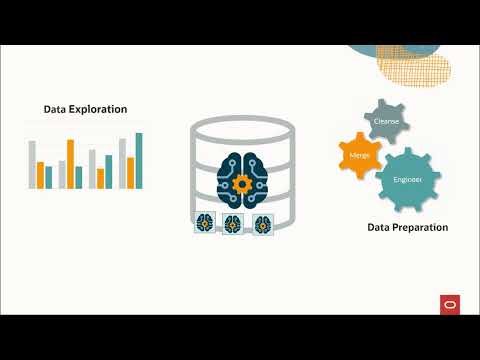Machine Learning in Oracle AI Database
Machine Learning in Oracle AI Database supports data exploration, preparation, and machine learning (ML) modeling at scale using SQL, R, Python, REST, automated machine learning (AutoML), and no-code interfaces. It includes more than 30 high performance in-database algorithms producing models for immediate use in applications. By keeping data in the database, organizations can simplify their overall architecture and maintain data synchronization and security. It enables data scientists and other data professionals to build models quickly by simplifying and automating key elements of the machine learning lifecycle.
 Oracle AI Database 26ai 以人工智慧推動資料革命
Oracle AI Database 26ai 以人工智慧推動資料革命
Oracle 將人工智慧應用於 Oracle AI Database 26ai 的核心架構中,加快實現 Oracle 協助客戶隨時隨地將人工智慧應用於所有資料之承諾。
-
Oracle Machine Learning for R updates
Oracle Machine Learning for R now supports Oracle R Distribution 4.4.1, delivering performance gains and enhanced features. It maintains compatibility with open source R 4.4.1 and provides optimized multicore processing and a streamlined developer experience.
Read the news about Oracle Machine Learning for R updates -
Prebuilt embedding generation model now available
A downloadable, augmented version of Hugging Face’s all-MiniLM-L12-v2 model in ONNX format is now available. Load it directly into Oracle AI Database and generate vector embeddings with Oracle AI Vector Search.
-
Semantic similarity search with multilingual support
Easily load an augmented version of Hugging Face’s multilingual embedding model, enabling semantic search across 100 languages for crosslinguistic use cases.
Why choose Machine Learning in Oracle AI Database?
Oracle AI Database supports data management, model development and deployment options, data and model monitoring, and team collaboration. Enhance productivity through built-in automation, in-database execution performance, and scalability. Identify possible bias in data and understand factors contributing to predictions.
In-database operations
Build models and score data faster and at scale without extracting data to separate analytics engines. Oracle Exadata’s scale-out architecture and Smart Scan technology help deliver results faster.
Multiple language APIs
Choose from SQL, Python, and R interfaces for in-database data exploration and preparation, machine learning modeling, and solution deployment. In addition, deploy Python and R solutions using SQL and REST.
No data movement
Process data where it resides in Oracle AI Database to simplify data exploration and preparation as well as model building and deployment. Shorten application development time, reduce complexity, and address data security.
No-code model building
Improve data scientist productivity and help nonexperts use powerful in-database algorithms for classification and regression through a no-code AutoML user interface.
Data and model monitoring
Gain insights into how your data and machine learning models evolve over time and take corrective action sooner to avoid issues that can have a significant negative impact on the enterprise. Use REST endpoints and no-code user interfaces.
Rapid enterprise deployments
Achieve immediate machine learning model availability with easy deployment options using SQL and REST interfaces.
Bring your own model
Import text transformer, classification, regression, and clustering models in Open Neural Network Exchange (ONNX) format to use from SQL with the in-database ONNX Runtime. Deploy ONNX format models to Oracle Machine Learning Services for real-time inferencing use cases.
High performance compute
Avoid performance issues during data preparation, model building, and data scoring using the built-in parallelism and scalability of Oracle AI Database, with unique optimizations for Oracle Exadata.
Built-in security
Benefit from Oracle AI Database’s built-in security and encryption, role-based access to user data, in-database and third-party models, and R and Python objects and scripts.
Machine Learning in Oracle AI Database customer successes
Build Your Agentic Solution Using Oracle Autonomous AI Database Select AI
Mark Hornick, Senior Director, Data Science and Machine Learning, Oracle
Explore how the Select AI empowers organizations to build and deploy agentic AI solutions. Learn what agentic AI is and how it’s different from traditional generative AI through a practical example of developing an intelligent, automated provisioning agent—all with simple integration.
Read the complete postFeatured blogs
- August 21, 2025 Oracle Machine Learning for R Now Supports Oracle R Distribution 4.4.1
- June 30, 2025 Building Machine Learning Models Using Data Through Analytics Publisher
- June 30, 2025 Accessing Analytics Publisher Reports Through Oracle Machine Learning Notebooks
- April 10, 2025 Announcing Oracle Machine Learning for Python 2.1
Resources

Getting started with machine learning in the cloud

Learn what’s new in the latest release
GitHub repository
Machine Learning in Oracle AI Database reference architectures
-
Reference Architecture
With Oracle Autonomous Data Warehouse, you have all the necessary built-in tools to load and prepare data and to train, deploy, and manage machine learning models. You also have the flexibility to mix and match other tools to best fit your organization’s needs.
-
Reference Architecture
Learn the design principles associated with creating a machine learning platform and an optimal implementation path. Use this pattern to create machine learning platforms that meet the needs of your data scientist users.
-
Reference Architecture
Get the framework to enrich enterprise application data with raw data from other sources, and then use machine learning models to bring intelligence and predictive insights into business processes.
-
Reference Architecture
Discover the platform topology, component overview, and recommended best practices for implementing a successful data lakehouse on OCI to capture a wealth of data and aggregate and manage data for real-time stock visibility.
Get started with Machine Learning in Oracle AI Database
Try Machine Learning in Oracle AI Database
Get started with Oracle Cloud and access Machine Learning in Autonomous Database—for free.
Follow us @OracleDatabase
Get the latest Oracle AI Database news, events, and community resources.
Contact us
Interested in learning more? Contact one of our industry-leading experts.




















